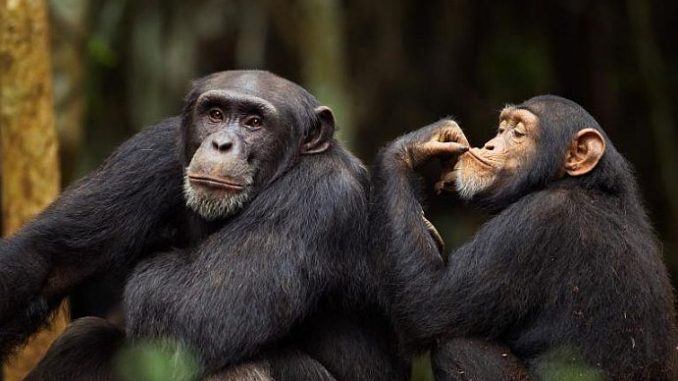
Chimpanzees in the west African country of Guinea have been seen to go on a booze-up with fellow chimps or even by themselves. They appear to show evolutionary characteristics similar to humans.
The wild chimpanzees of a colony in Bossou were observed by scientists to not be impervious to palm wine. They are seen at times sitting alone at the top of a raffia palm tree getting merry on their own or in groups, drinking from sap-gathering containers. The containers are used by the locals to collect a sweet, milky sap extracted from raffia palms which then ferments into an alcoholic drink. The clever chimps even use the cover of the containers as a dipping tool to extract ethanol (alcohol) from the containers.

BYPASS THE CENSORS
Sign up to get unfiltered news delivered straight to your inbox.
You can unsubscribe any time. By subscribing you agree to our Terms of Use
Latest Video
The scientists monitoring the behavior of the wild chimps have noticed an evolutionary link with humans. The chimps seem to drink only when they are alone or in a group otherwise they will stay away from the booze. Their drinking habits just like in the human population could get out of hand if done in excess, in which case they might turn into ‘apes’. Human and apes have the ability to metabolize alcohol which goes back to our common ancestry and the fight for survival. It stems from the need to be able to utilise rotten ‘fermented’ fruits found at bottom of trees in ancient forests.
News 24 reports:
The apes scrunched up leaves in their mouths, moulding them into spongy pads that they then dipped into the sap-gathering container, which villagers attach to the tree near its crown.
Tests showed that the beverage’s alcoholic content varied from 3.1 per cent to a whopping 6.9 per cent, the equivalent of strong beer.
Some of the chimps went a little, well, ape.
“[They] consumed significant quantities of ethanol (alcohol) and displayed behavioural signs of inebriation,” the paper said soberly.
“Researchers rarely collected detailed behavioural data before versus after exposure to ethanol, but some drinkers rested directly after imbibing fermented sap.”
The chimps are part of a closely-observed colony at Bossou in southern Guinea and scientists said the discovery of booze-ups helped shed light on a theory about evolution.
In 2008, one of the animals made the headlines when he was found to use a stick to “fish” for ants – an important discovery in the use of tools by our primate cousins.
Cases of animals ingesting alcohol are not exceptional. They include Swedish moose that get drunk on fermented apples, and monkeys on the Caribbean island of St. Kitts that sneak gulps from vacationers’ cocktails.
But the Bossou chimps, observed over 17 years, are the first to provide serious data about how much alcohol can be knocked back in the wild, and when.
Sometimes, just a single chimp would go to the top of the palm, the researchers found.
But on occasions, there would be “drinking sessions” when several chums would gather in the crown of the tree.
“Individuals either co-drank, with drinkers alternating dips of their leaf-sponges into the fermented palm sap, or one individual monopolised the container, whereas others waited their turn.”
Over the 17 years, the researchers recorded 51 drinking events, 20 of which were “drinking sessions.” They identified 13 adult and young chimps.
The cheeky animals made their sponges from leaves that villages had placed over the top of the containers to prevent dust and insects from contaminating the sap.
The findings support the so-called “drunken monkey” theory – that apes and humans share a genetic ability to break down alcohol that was handed down from a common ancestor.
By metabolising alcohol, according to this idea, our forerunners could eat fermented fruit found on the forest floor, gaining a precious additional source of calories and vitamins.
The study, headed by Kimberley Hockings of Oxford Brookes University, appeared in the British journal Royal Society Open Science.
……………………………
Drunk Monkeys Fail – Weird Nature
JohnDownerProd YouTube video:
300 years ago vervet monkeys were brought into the island of St. Kitts from West Africa. The monkeys that escaped acquired a taste for alcohol by eating the fermented sugar cane left in the fields. Today, they raid local bars to satisfy their thirst.


